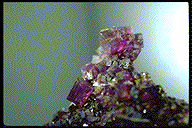 THE MINERAL CALOMEL
THE MINERAL CALOMEL
- Chemistry: HgCl, Mercury Chloride
- Class: Halides
- Uses: As a minor ore of mercury and as mineral specimens.
- Specimens
Calomel is a somewhat rare mineral and is never found in large quantities.
It is most often a secondary mineral that forms from the alteration of
cinnabar or other mercury minerals.
It also is deposited from hot underground solutions.
Its common habit is as coatings on other minerals.
The luster is very high and attractive and some specimens show a nice fluorescent red under ultraviolet light.
PHYSICAL CHARACTERISTICS:
- Color is white, gray or yellow.
- Luster is adamantine.
- Transparency: Crystals are translucent.
- Crystal System is tetragonal; 4/m 2/m 2/m
- Crystal Habits are small tabular to pyramidal or horn-like crystals usually seen as coatings or crusts on other minerals.
- Cleavage is distinct in one direction.
- Fracture is conchoidal.
- Hardness is 1 - 2.
- Specific Gravity is 6.4 - 6.5 (very heavy for translucent minerals)
- Streak is white.
- Other Characteristics: Fluorescent red and crystals darken upon exposure to light over time.
- Associated Minerals include mercury, cinnabar, metacinnabar and other mercury minerals.
- Notable Occurrences include Almaden, Spain; Idria, Serbia; Hunan Prov., China and New Idria, California, Oregon, Terlingua, Texas, and Arkansas, USA.
- Best Field Indicators are density, associations, fluorescence, hardness and crystal habit.







